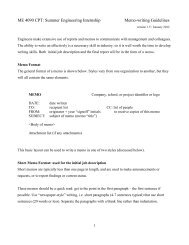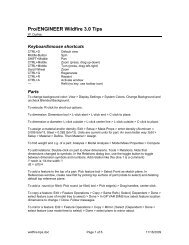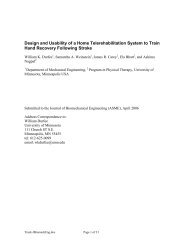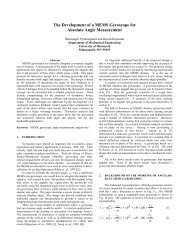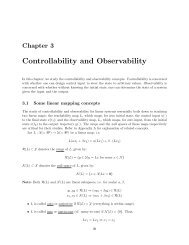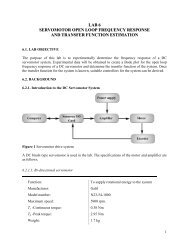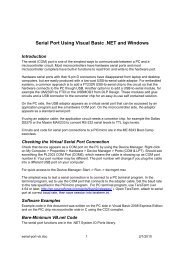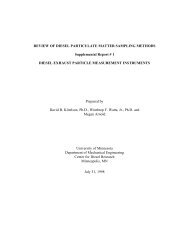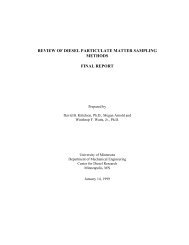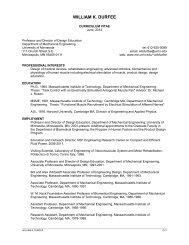A Design Tool for Aerodynamic Lens Systems - Department of ...
A Design Tool for Aerodynamic Lens Systems - Department of ...
A Design Tool for Aerodynamic Lens Systems - Department of ...
You also want an ePaper? Increase the reach of your titles
YUMPU automatically turns print PDFs into web optimized ePapers that Google loves.
328 X. WANG AND P. H. MCMURRY<br />
TABLE 1<br />
Key features <strong>of</strong> four lens assemblies with step accelerating nozzles used in particle axial velocity comparison<br />
<strong>Lens</strong> system dn (mm) ds (mm) dt (mm) Lt (mm) Gas p1 (Pa) dp (nm)<br />
A(Wang et al. 2005b) 2.76 10 6 5 He 528 3–30<br />
B (Liu et al. 1995b) 3.0 10 6 10 Air 93–333 25–250<br />
C (TSI AFL-050) 3.2 17.78 7.62 17.78 Air 250 50–500<br />
D (TSI AFL-100) 1.48 17.78 7.62 17.78 Air 600 100–3000<br />
Estimation <strong>of</strong> Particle Beam Widths<br />
The particle beam width is defined as the beam diameter that<br />
encloses 90% <strong>of</strong> the total particle flux. In this section expressions<br />
are given that are used in the Calculator to calculate particle beam<br />
widths downstream <strong>of</strong> each lens as well as downstream <strong>of</strong> the<br />
accelerating nozzle. Bean widths are controlled by two factors:<br />
aerodynamic focusing and diffusion broadening. The focusing<br />
can be inferred from Figure 2, and the diffusion broadening<br />
can be estimated by the root mean square displacement xrms √ =<br />
2Dt, where D is the particle diffusion coefficient, and t is the<br />
particle residence time.<br />
Assuming the diameters <strong>of</strong> spacers upstream and downstream<br />
<strong>of</strong> the pressure limiting orifice (lens 0) are the same, the flow<br />
is fully developed upstream <strong>of</strong> the pressure limiting orifice, and<br />
particles are homogenously distributed in the flow cross section,<br />
the starting particle beam diameter enclosing 90% flux is then<br />
∼0.827ds,0. The particle beam diameter be<strong>for</strong>e reaching lens 1<br />
is<br />
dB,0 = 0.827ds,0ηc,0 + xrms,0. [20]<br />
The beam diameter dB,i at stage i inside the lens system can be<br />
easily calculated as<br />
dB,i = dB,i−1ηc,i + xrms, i, i = 1ton. [21]<br />
However, we should note that dB,i may exceed the spacer diameter<br />
ds,i due to defocusing or diffusion. In that case, we assume<br />
all particles outside the beam diameter <strong>of</strong> ds,i are lost and reset<br />
dB,i = 0.827 ds,i.<br />
Assuming particles achieve a Maxwell-Boltzmann distribution<br />
<strong>of</strong> radial velocities downstream <strong>of</strong> the acceleration nozzle<br />
(lens n + 1), we can estimate the particle beam width at a distance<br />
L downstream <strong>of</strong> the nozzle as follows:<br />
dB,n+1 = dB,nηc,n+1 + 3.04<br />
�<br />
2kTpF<br />
m p<br />
L<br />
. [22]<br />
Note that ηc,n+1is only a very rough estimate because the pressure<br />
downstream <strong>of</strong> the nozzle is so low that the definition <strong>of</strong><br />
contraction factor is no longer valid.<br />
u p<br />
Estimation <strong>of</strong> Particle Transmission Efficiencies<br />
Particle losses in an aerodynamic lens system arise from impaction<br />
and diffusion. Particle impaction happens both on the<br />
orifice plate and on the spacer walls.<br />
We can view the orifices (including the pressure limiting<br />
orifice, lenses and the nozzle) as an impactor plate. Particles<br />
with large Stokes numbers will fail to follow streamlines and<br />
will impact on the plate. There<strong>for</strong>e, it is appropriate to use the<br />
spacer Stokes number (Sts) tocharacterize particle impaction<br />
on the orifice plate. The characteristic velocity and length in<br />
Sts are the average flow velocity in the spacer (Us) and the<br />
spacer inner diameter (ds), respectively, i.e., Sts = τUs/ds,<br />
where Us = 4 Q/(π d2 s ). Figures 10(a)–(c) show the particle<br />
transmission efficiency as a function <strong>of</strong> Sts, Re and Ma <strong>for</strong> the<br />
same conditions as those in Figure 2. The corresponding Stokes<br />
numbers based on orifice are also shown in the figures. Note<br />
that significant particle losses happen in the Sts range <strong>of</strong> 0.1–1<br />
<strong>for</strong> all Reynolds and Mach numbers. Although losses in these<br />
figures consist <strong>of</strong> both losses on the orifice plate and the downstream<br />
spacer walls, examination <strong>of</strong> particle trajectories shows<br />
that most losses are due to impaction on the orifice plate <strong>for</strong> these<br />
particular simulations. The transmission curves asymptotically<br />
reach ηt = 2( d f<br />
ds )2 − ( d f<br />
ds )4 <strong>for</strong> very large Stokes numbers corresponding<br />
to geometrical blocking <strong>of</strong> the orifice plate (Zhang<br />
et al. 2002). Figure 11 shows the cut<strong>of</strong>f Stokes number (Sts50)<br />
at which the transmission efficiency is 50% as a function <strong>of</strong> Re<br />
<strong>for</strong> the three Ma’s studied. From Figure 10 we can see that the<br />
impaction particle loss is relatively steep. There<strong>for</strong>e, the particle<br />
transmission efficiency through the stage from lens i–1 to<br />
lens i only considering impaction losses on the orifice plate i,<br />
ηt, orifice, i, can be estimated as a step function:<br />
ηt, orifice, i =<br />
⎧<br />
⎪⎨<br />
1 <strong>for</strong> Sts < Sts50 or dB,i−1 ≤ d f,i<br />
� � d f,i ) 2 � � d 4<br />
f,i<br />
2 d −<br />
s,i−1 d .<br />
s,i−1<br />
⎪⎩<br />
�4 <strong>for</strong> Sts ≥ Sts50 and dB,i−1 > d f,i<br />
� � dB,i−1<br />
2 � dB,i−1<br />
2 d −<br />
s,i−1 ds,i−1 [23]<br />
Note that non-uni<strong>for</strong>m particle concentration due to focusing by<br />
upstream lenses is taken into consideration in this equation.<br />
Defocused particles will be lost to the wall when ηc < −1.<br />
In this case, the initial particle radial position upstream <strong>of</strong> the



